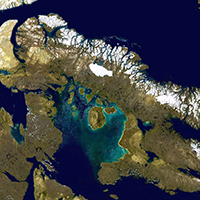Physical and chemical characteristics of 1300 lakes and ponds across the Canadian Arctic
Characteristics of Canadian Arctic lakes and ponds

Accepted: 25 August 2020
Supplementary: 107
HTML: 255
All claims expressed in this article are solely those of the authors and do not necessarily represent those of their affiliated organizations, or those of the publisher, the editors and the reviewers. Any product that may be evaluated in this article or claim that may be made by its manufacturer is not guaranteed or endorsed by the publisher.
Authors
Lakes and ponds are a major feature of the Arctic landscape and are recognized as effective ‘sentinels of change’. Here we present water chemistry characteristics of lakes and ponds (n=1300 with 26 variables) across the Canadian Arctic collated from published studies. We also extracted geological and ecoregion data in an attempt to determine the key drivers. In general, most lakes were shallow (85.4%, <10 m), nutrient (phosphorus) poor (oligotrophic = 45.6% and ultra-oligotrophic = 24.8%), located at low elevation (66.5%, <200 m asl), close to coastlines (72.5%, 0-50 km), and underlain by sedimentary geology (66.5%). The first two components from Principal Component Analysis explained 49.3% of the variation in the dataset; the first component was dominated by conductivity/carbonate materials, and the second component suggested allochthonous inputs of phosphorus. In general, bedrock geology is the primary driver of water chemistry; as such, there were major differences between lakes underlain by igneous and sedimentary rocks. Those on sedimentary bedrock tend to have higher pH, nutrients and higher inorganic ion concentrations.
Edited by
Michela Rogora, CNR-IRSA Verbania, ItalyHow to Cite
Similar Articles
- Cristiana Callieri, Edoardo Mandolini, Roberto Bertoni, Rosaria Lauceri, Antonio Picazo, Antonio Camacho, Pedro Jose Cabello-Yeves, Atlas of picocyanobacteria monoclonal strains from the collection of CNR-IRSA, Italy , Journal of Limnology: Vol. 80 No. 1 (2021)
- Ubirajara L. Fernandes, Elaine C.C. de Oliveira, Sírleis R. Lacerda, Role of macrophyte life forms in driving periphytic microalgal assemblages in a Brazilian reservoir , Journal of Limnology: Vol. 75 No. 1 (2016)
- Tiziana Alterio, Roberto Guidetti, Deborah Boschini, Lorena Rebecchi, Heat shock proteins in encysted and anhydrobiotic eutardigrades , Journal of Limnology: Vol. 71 No. 1 (2012)
- Helmut KLAPPER, Technologies for lake restoration , Journal of Limnology: Vol. 62 No. s1 (2003): Residence Time in Lakes: Science, Management, Education
- Kenneth W. Cummins, Combining taxonomy and function in the study of stream macroinvertebrates , Journal of Limnology: Vol. 75 No. s1 (2016): Proceedings of the 6th National Congress of Limnology
- Norma Fernanda Charqueño Celis, Martin Garibay, Itzel Sigala, Mark Brenner, Paula Echeverria-Galindo, Socorro Lozano, Julieta Massaferro, Liseth Pérez, Testate amoebae (Amoebozoa: Arcellinidae) as indicators of dissolved oxygen concentration and water depth in lakes of the Lacandón Forest, southern Mexico , Journal of Limnology: Vol. 79 No. 1 (2020)
- Enrico Bonatti, Hutchinson’s tree , Journal of Limnology: Vol. 80 No. 3 (2021): Celebratory Issue - 80th Anniversary of the Journal of Limnology
- Giampaolo Rossetti, Elena Bellavere, Ilaria Mazzini, First record of males of Cypridopsis vidua (Crustacea, Ostracoda) species complex for Europe , Journal of Limnology: Vol. 83 (2024)
- Lynn Van Den Broecke, Koen Martens, Valentina Pieri, Isa Schön, Ostracod valves as efficient UV protection , Journal of Limnology: Vol. 71 No. 1 (2012)
- Valeria Rossi, Alessio Martorella, Paolo Menozzi, Hatching phenology and voltinism of Heterocypris barbara (Crustacea: Ostracoda) from Lampedusa (Sicily, Italy) , Journal of Limnology: Vol. 72 No. 2 (2013)
<< < 46 47 48 49 50 51 52 53 54 55 > >>
You may also start an advanced similarity search for this article.
-
Jonathan B. Martin, Andrea J. Pain, Ellen E. Martin
-
Zhizhong Li, Madjid Hadioui, Kevin J. WilkinsonNanomaterials : 2023

 https://doi.org/10.4081/jlimnol.2020.1973
https://doi.org/10.4081/jlimnol.2020.1973





